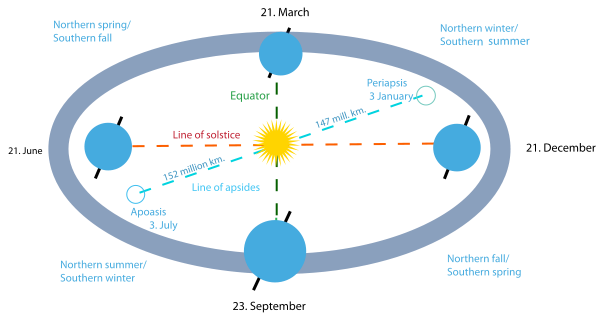A season is a division of the year marked by changes in the weather. In temperature and polar regions they are named spring, summer, autumn, and winter. In tropical and subtropical regions they are usually named rainy and dry seasons.

The seasons are caused by the 23.5 degree tilt in the Earth's axis. It causes the sun to be at a higher altitude during summer months and lower during winter months, this is called a solstice.At other times the sun is neither more inclined toward the north or south and this is called an equinox. This means at any given time one part of the earth is more exposed to the sun than the other. Therefore the northern and southern hemispheres always experience opposite seasons. Solstices only occur twice a year.If the sun is inclined more towards the southern tropic, Tropic of Capricorn , it is the south's summer solstice. If the sun is inclined more towards the north on the northern tropic,Tropic of Cancer, it is the north's winter solstice. This also effects day length. In the summer solstice June 21 is often called 'the longest day' and December 21 is called 'the shortest day.' This is because if the sun is more inclined toward a certain area they receive more sunlight and the day becomes longer. Days in summer months are usually longer and since the sun is farther away during winter months this makes days shorter. Equinoxes also occur twice a year during the spring and fall months. This is when the earth is inclined neither toward or away from the sun, the sun being vertically above a point on the equator.On September 21 this is the autumnal(autumn) equinox and March 21 is the vernal (summer) equinox.This as well effects the length of day. Both the northern and southern hemispheres receive 12 hours of sunlight and 12 hours of darkness.
